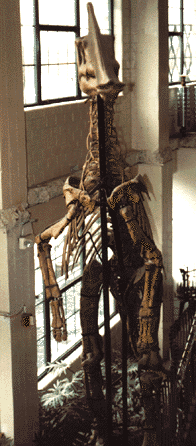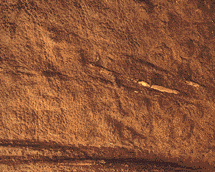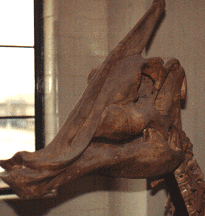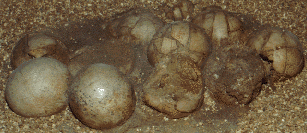
Saurolophus
anilustirostris -Rozhdestvensky, 1957- skeleton
Archosauria: Ornithischia: Ornithopoda:
Hadrosauridae
Locality: Altan Ula, Nemegt Basin, Gobi Desert,
southern Mongolia
Age: Late Cretaceous (Late Campanian-Early Maastrichtian),
74 million years ago
Meaning of name: "ridged or crested reptile"
Size:
10 meters long
Saurolophus
is one of the largest representatives of the hadrosaurids, or duck-billed
dinosaurs.
The tooth-less anterior parts of the jaws in Saurolophus were flattened and
widened,
like a duck bill. At the same time, the numerous lateral teeth were well
developed,
so the animal could cut and chew very effectively aquatic vegetation which
was
probably its regular forage. Indeed, both the vertically-flattened tail and wide
paws
suggest that Saurolophus might reside in shoals and coastal environments.
The posterior
part of the skull roof in Saurolophus forms a long backward directed
spine with inner
hollows connected to aerial ducts. Many dinosaurologists think
these hollows might be
acoustic resonators, that could reinforce vocalisation
in Saurolophus and other species of
the hadrosaurids. Relatively well-developed
fore limbs in Saurolophus suggests it might
be quadrupedal when moving slowly,
but could take bipedal stance when travelling faster.
Saurolophus is also well
known in North America. There, as in Mongolia, it is common
in
flood plain deposits. Saurolophus angustirostris was
one of the biggest
hadrosaurs.
Saurolophus
anilustirostris -Rozhdestvensky, 1957- fragment of fossil skin
Archosauria: Ornithischia:
Ornithopoda: Hadrosauridae
Locality: Altan Ula, Nemegt
Basin, Gobi Desert, southern Mongolia
Age: Late Cretaceous (Late Campanian-Early
Maastrichtian), 74 million years ago
Skin
impressions of hadrosaurs are common both in North America and Central Asia. These
impressions show that these animals had a scale pattern typical of reptiles.
Saurolophus had a horny beak that lacked any teeth.
They also had a battery of
cheek teeth good for processing resistant vegetation.
The skull bones at the
back of the head formed a spike which continued behind the head.
The flattened
tail and the paddle-like hands suggest that this duck-billed hadrosaur
spent
part of its life in water.
Nest
of hadrosaur eggs
Archosauria: Ornithischia: Ornithopoda: Hadrosauridae
Locality:
Gobi Desert, southern Mongolia
Age: Late Cretaceous
(Late Campanian-Early Maastrichtian), 74 million years ago




